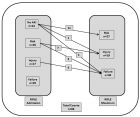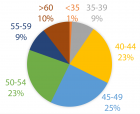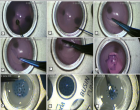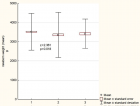Table of Contents
The inflammatory profile of chronic kidney disease patients
Published on: 20th December, 2021
OCLC Number/Unique Identifier: 9396216755
Background: Chronic kidney disease is a worldwide public health issue which is associated with an increased risk of end-stage renal failure and cardiovascular disease. Systemic inflammation exists during chronic renal failure. Recent researches have highlighted the pivotal role of inflammation between renal and cardiovascular disease. The aim of our study is to determine the inflammatory profile of the patient suffering from chronic kidney disease and the influence of hemodialysis on this profile.Methods: We carried out a cross sectional study on 93 patients in the Nephrology Department at Hedi Chaker University Hospital, Sfax, South of Tunisia. Among those patients, 72 patients underwent hemodialysis and 21 patients had chronic kidney disease at stage 3. Clinical data and antecedents were collected. Biological samples were taken after informing the patients and taking their consent. Biological data consisted in lipid profile, albumin rate, hemoglobin rate, uric acid concentration and the usual markers of inflammation noting sedimentation rate, C - reactive protein and orosomucoid.Results: Hemodialysis group of the 72 patients had mean hemodialysis vintage of 54.6 ± 43 months. The inflammatory profile was worse in hemodialysis patients compared to chronic kidney disease patients. Both sedimentation rate, C - reactive protein and orosomucoid were higher in hemodialysis group than in chronic kidney disease group with 71 ± 35.3 mm vs. 42.1 ± 15.5 mm (p < 0.05); 14.6 ± 28.7 mg/l vs. 6.7 ± 8 mg/l (p = 0.02); 1.3 ± 0.7g/l vs. 0.9 ± 0.4 g/l (p = 0.01), respectively.Conclusion: Inflammation increases in dialysis patient. It deserves the nephrologist’s consideration in order to minimize its harmful effects. The monitoring of inflammation markers must be integrated into the nephrologist’s medical practice.
Effects of secondary hyperparathyroidism treatment on hemoglobin levels and erythropoietin doses in hemodialysis patients
Published on: 15th October, 2021
OCLC Number/Unique Identifier: 9324267313
Aim: Secondary hyperparathyroidism (SHPT) is an often underestimated cause of anemia in hemodialysis (HD) patients. The aim of this study was to assess the effect of pharmacological correction of SHPT on anemia and erythropoiesis-stimulating agents (ESAs) need. Methods: For the purpose of this retrospective pre-post observational study, we selected 55 HD patients, receiving HD at one single center, in the period from January 2005 to December 2020. The follow-up (F-U) lasted 12 months. The selection criteria were parathormone (PTH) levels > 300 pg/ mL, and hemoglobin (Hb) levels < 11 g/dL, despite treatment with ESAs. Parametric and non-parametric tests were used when appropriate. In the light of exploratory nature of the study, the limited sample size and in consideration of the pre-post-design, no further adjustment for potential confounders is performed. Results: The hemoglobin levels throughout the study were correlated to serum PTH (r = -.257, p < 0.01). At the end of the F-U, in the 40 patients whose PTH levels decreased ≥ 30% (responders group) Hb levels increased from 10.3 ± 0.5 g/dL to 12.2 ± 1.1 g/dL (p < 0.001), and ESAs doses decreased from 141 ± 101 IU/kg/b.w./week to 94 ± 76 IU/kg/b.w./week (p < 0.05). On the contrary, in the non-responders group Hb levels did not change 10.3 ± 0.5 gr/dL at baseline and 10.1 ± 1.1 gr/dL at F-U (P = NS), and the mean doses of ESAs increased from 144 ± 75 IU/kg/b.w./week to 218 ± 145 IU/kg/b.w./week (P = NS). Conclusion: Adequate control of SHPT is associated with concomitant improvement of anemia and decrease in ESAs need. Future endeavors are required to confirm these preliminary results.
Membranous nephropathy complicating relapsing polychondritis: A case report
Published on: 7th October, 2021
OCLC Number/Unique Identifier: 9305467462
Background: Relapsing polychondritis is a rare systemic disease characterized by recurrent inflammation, and often destruction, of cartilaginous tissues. Renal manifestations are rare. Membranous nephropathy complicating relapsing polychondritis has been reported only once previously, and there is no standardized treatment for membranous nephropathy associated with relapsing polychondritis.Case presentation: A 67-year-old Caucasian man with a history of chronic renal disease presented with 9 months of progressive dyspnea on exertion and 5 months of erythema, pain, and collapse of auricular cartilage. Imaging studies confirmed active inflammation of laryngeal, auricular, and costal cartilage and he was diagnosed with relapsing polychondritis. Patient had longstanding proteinuria and renal biopsy demonstrated membranous nephropathy. Patient initially showed renal and respiratory improvement with etanercept, a tumor necrosis factor alpha inhibitor, treatment. However, subsequent disease and treatment-related complications led to a progressive overall clinical decline and patient died approximately 1 year following relapsing polychondritis diagnosis.Conclusion: Membranous nephropathy may rarely complicate relapsing polychondritis. In our case, both the cartilaginous inflammation and the renal disease improved after treatment with tumor necrosis factor alpha blockade, however complications of existing airway disease led to recurrent hospitalizations and eventually death.
A case of resistant hypercalcemia in a peritoneal dialysis patient with underlying Vitamin A toxicosis
Published on: 7th October, 2021
OCLC Number/Unique Identifier: 9305374138
Hypercalcemia in End Stage Renal Disease on Dialysis, is a frustrating complication for both medical staff and patients, and it may lead to vascular calcification, Calciphylaxis, and even aggravating cardiovascular disease, even in the absence of risk factors which can lead to early death [1], and correcting Hypercalcemia even in the absence of hyperphosphatemia is out most important to improve co-morbid conditions and reduce mortality, most common causes in end stage renal disease, includes high calcium dialysis bath, high dietary intake of Calcium rich food, exogenous intake of calcium products, or excessive intake of Vitamin D, underlying Sarcoidosis, rare causes need to be explored in resistant cases, including Vitamin A toxicosis, as being presented in this case.
Safety and efficacy of sofosbuvir based regimen in the treatment of hepatitis C virus infection among hemodialysis patients in Morocco
Published on: 26th September, 2021
OCLC Number/Unique Identifier: 9244749614
The introduction of a new class of drugs known as direct acting antiviral (DAA) agents represents a revolution in the treatment of hepatitis C virus (HCV) in the general population, as these regimens are associated with higher sustained virological response (SVR) rates and fewer side effects. However, for patients with advanced chronic kidney disease suffering from HVC infection, treatment options including DAA remain limited. The aim of this study is to report our experience on Sofosbuvir (SOF) based regimen in the treatment of HCV in hemodialysis patients.In this observational study, we included all patients with chronic HCV infection on hemodialysis who were treated with SOF in our Hospital between April 2016 and March 2018. All patients were treated with a combination of 400 mg of SOF three times a week after hemodialysis and of 60 mg of Daclatasvir daily for a total of 12 to 24 weeks.A total of 20 hemodialysis patients were included in this study. 12 were females and the mean age was 52.1 ± 15.5 years. 11 patients were infected with HCV genotypes 1b. All patients achieved SVR. Clinical and biological tolerance was very good for all patients and none of them had to discontinue treatment because of side effects or developed hepatobiliary and cardiac toxicity. Two patients reported fatigue and another patient reported headaches. However, these symptoms were spontaneously resolved after the end of the treatment.In Morocco, despite the absence of new DAA combination treatment regimens which are not renally eliminated, our study concludes that SOF based treatment without Ribavirin or Peginterferon was effective and safe with minimal side effects. However, larger studies are still needed in order to validate these results.

HSPI: We're glad you're here. Please click "create a new Query" if you are a new visitor to our website and need further information from us.
If you are already a member of our network and need to keep track of any developments regarding a question you have already submitted, click "take me to my Query."

























































































































































